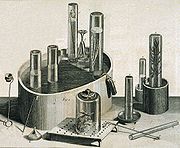
Pneumatic trough
Encyclopedia

Hydrogen
Hydrogen is the chemical element with atomic number 1. It is represented by the symbol H. With an average atomic weight of , hydrogen is the lightest and most abundant chemical element, constituting roughly 75% of the Universe's chemical elemental mass. Stars in the main sequence are mainly...
, oxygen
Oxygen
Oxygen is the element with atomic number 8 and represented by the symbol O. Its name derives from the Greek roots ὀξύς and -γενής , because at the time of naming, it was mistakenly thought that all acids required oxygen in their composition...
, and nitrogen
Nitrogen
Nitrogen is a chemical element that has the symbol N, atomic number of 7 and atomic mass 14.00674 u. Elemental nitrogen is a colorless, odorless, tasteless, and mostly inert diatomic gas at standard conditions, constituting 78.08% by volume of Earth's atmosphere...
. Pneumatic troughs require a liquid such as water. Scientists also have used mercury in pneumatic troughs, but usually only for the collection of water-soluble gases. Health-and-safety issues surrounding mercury generally prohibit its use in modern-day pneumatic troughs.
Four items are required for gas collection with a pneumatic trough:
- The trough itself, which is a large glass dish or a similar container
- A gas bottle (or bulb), to hold the gas collected
- A way to support the gas bottle or bulb, such as a Beehive shelfBeehive shelfA beehive shelf is a piece of laboratory equipment, usually of pottery, used to support a receiving jar or tube while a gas is being collected over water with a pneumatic trough.History....
or a hanger (see picture) - A liquid in the trough
The bottle is filled with water, inverted, and placed into the pneumatic trough already containing water. The outlet tube from the gas-generating apparatus is inserted into the opening of the bottle so that gas can bubble up through it, displacing the water within.
See also

- Beehive shelfBeehive shelfA beehive shelf is a piece of laboratory equipment, usually of pottery, used to support a receiving jar or tube while a gas is being collected over water with a pneumatic trough.History....
- Pneumatic chemistryPneumatic chemistryPneumatic chemistry is a term most-closely identified with an area of scientific research of the seventeenth, eighteenth, and early nineteenth centuries. Important goals of this work were an understanding of the physical properties of gases and how they relate to chemical reactions and,...
- Joseph PriestleyJoseph PriestleyJoseph Priestley, FRS was an 18th-century English theologian, Dissenting clergyman, natural philosopher, chemist, educator, and political theorist who published over 150 works...
- Stephen HalesStephen HalesStephen Hales, FRS was an English physiologist, chemist and inventor.Hales studied the role of air and water in the maintenance of both plant and animal life. He gave accurate accounts of the movements of water in plants, and demonstrated that plants absorb air...

